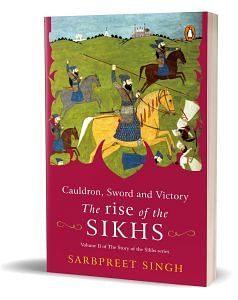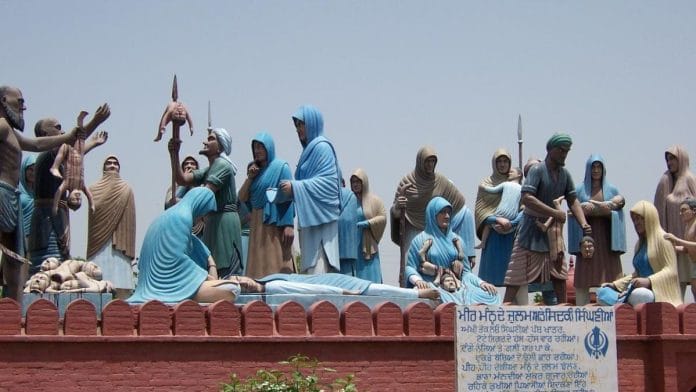In early 1736, a band of Sikhs under the command of Jassa Singh Ahluwalia were attacked by Jaspat Rai in the western Shivalik hills. The Sikhs fled towards the west and reached the vicinity of Eminabad, where they sheltered in the forests close to the village of Badokki.
The Sikhs had set up camp and were preparing their evening meal when a messenger from Jaspat Rai arrived. Jaspat Rai demanded that they leave his territories at once. The Sikhs said that they had been in the saddle for three days and were tired and hungry. They swore that they bore Jaspat Rai no ill will and they would leave soon. The haughty Jaspat Rai was having none of it. Threatening that he would shave all of their heads, he attacked just as the Sikhs were about to eat. Their camp encircled by Jaspat Rai’s forces, the trapped Sikhs broke out of the cordon and instead of fleeing, wheeled around and engaged Jaspat Rai in an open field. Jaspat Rai’s forces, taken aback by the ferocity of the attack, beat a hasty retreat.
A daring Sikh named Nibab Singh grabbed the tail of Jaspat Rai’s elephant and clambered into the howdah. In an instant, Jaspat Rai’s decapitated head fell to the ground. After the battle, Bawa Kirpa Ram Gosaian, who was the spiritual mentor of Jaspat Rai, came to claim the head, which the Sikhs made over to him for a sum of 500 rupees.
Kirpa Ram hastened to Lahore with Jaspat Rai’s head and laid it at the feet of Diwan Lakhpat Rai, who swore vengeance and left for Eminabad to look for Jassa Singh Ahluwalia and his men. Yahiya Khan, his master, immediately issued a proclamation that Sikhs be massacred. Lakhpat Rai searched for the Sikhs in vain and returned to Lahore, frustrated. Sikh shopkeepers and merchants were rounded up and some were killed.
A group of prominent citizens, including a well-known Hindu leader, Kaura Mal, and Gosain Sant Jagat Bhagat, Lakhpat Rai’s own spiritual mentor, approached the Diwan. Jaspat Rai had fallen in battle, they said. Lakhpat Rai was within his rights to pursue his killers, but the common Sikhs of Lahore had done nothing and they suggested that the rest of the detained Sikhs be released. Lakhpat Rai, however, was adamant and insulted the delegation, telling Jagat Bhagat that he knew nothing of politics and governance. The holy man was so offended that he cursed Lakhpat Rai and prophesied that while the Sikhs would thrive, the Diwan’s name would be obliterated. On 10 March, all the arrested
Sikhs were put to death.
Also Read: ‘Throne of Indira will crumble. They will chew iron lentils’—Bhindranwale in 1984
Lakhpat Rai now put together a large force and started looking for the Sikh warriors who had killed his brother. At that time, about 15,000 Sikhs were in hiding in the marshes around the village of Kahnuwan. The leaders present there with their bands were Nawab Kapur Singh, Jassa Singh Ahluwalia, Sukha Singh, Gurdial Singh Dallewala and Charat Singh Shukerchakia.
Lakhpat Rai’s army encircled them and the Sikhs started to engage them with their usual hit and run tactics. The Mughal force was huge and equipped with artillery and the lightly provisioned Sikhs knew that they were in trouble. Many of them were on foot and escape seemed impossible. They launched several daring raids on Lakhpat Rai’s camps, managed to capture several horses and made off with the Mughal army’s provisions.
An enraged Lakhpat Rai ordered his men to intensify their attack and the Sikhs, reeling from the fierce onslaught, tried to flee. They reached the banks of the Ravi river and managed to cross, intending to make their way to Kathua and then on to Basohali, where they could shelter in the mountains. Their path was, however, impeded by bands of hillmen, enemies of the Sikhs, who showered them with bullets. Trapped between the hillmen and Lakhpat Rai’s forces that were in pursuit, the Sikhs split up into several bands to make it easier to escape towards the south.
The Ravi, by then, was swollen and the Sikhs were unable to cross. Jassa Singh decided that it was better to die fighting than drowning and a detachment of Sikhs led by Sukha Singh turned around to engage the pursuers. In the pitched battle that followed, the son of Lakhpat Rai and Yahiya Khan’s son Nahar Khan, along with several other Mughal commanders, were killed. Sukha Singh’s thigh bone was shattered but he bandaged his leg and kept fighting. The battle was fought on 1 May 1746. In all the years of repression and resistance, the Sikhs had never suffered such significant casualties. Seven thousand Sikhs lost their lives and 3000 were captured, including those detained by the Hill Rajas. Lakhpat Rai dragged the captured Sikhs in chains to Lahore, where they were executed.
The Sikh warriors scattered in order to survive. Nawab Kapur Singh, Jassa Singh Ahluwalia and Sukha Singh went to the Malwa and sheltered at Kot Kapura.
The episode came to be known as the Chotta Ghallughara or the Smaller Holocaust.
 This excerpt from Sarbpreet Singh’s ‘Cauldron, Sword and Victory: The Rise of the Sikhs’, has been published with permission from Penguin Random House.
This excerpt from Sarbpreet Singh’s ‘Cauldron, Sword and Victory: The Rise of the Sikhs’, has been published with permission from Penguin Random House.






